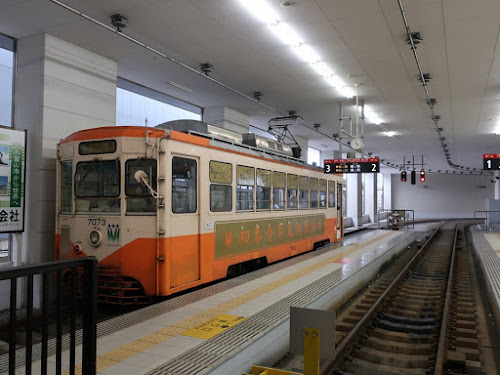Takaoka city has prospered as a foundry town and a port of Kitamaebune. Mikurumayama festival has strengthened the bond of this city and boosted it. I felt strong passion of the people who continue performing the festival and enjoy the only 2-day festival every year from the bottom of their hearts. It is designated as UNESCO world heritage.
鋳物の製造と北前船の寄港地として栄えた高岡の町。江戸初期から始まる御車山祭が、町を纏まらせて、町を活気づけている。祭りを続け、年に二日間の祭りで盛り上がる人々の熱気を感じる。ユネスコ無形文化遺産に登録されている。
 |
The actual float of Mikurumayama festival,
float of Moriya-machi、御車山の実物(守山町)
|
 |
After the massive fire in 1900, many fire-proof
buildings “Kura” were built. Floats parade on this street. 1900年の大火の後、蔵造りが増えた山町筋。御車山祭の山車が通る。
|
 |
Mikurumayama museum is on this street.
御車山会館はこの通りにある。
|
 |
There is a message at the entrance of the
exhibition area. It is written “The origin was a royal visit to the ruler
Hideyoshi’s villa in 1588. 展示室へのアプローチは、素敵なメッセージで始まる。
|
 |
There is a picture of a folding screen
which shows “Hideyoshi invited the emperor to his new-built villa called “Jurakudai”
in Kyoto. 扉を開けると、1588年に、秀吉が完成した聚楽第に後陽成天皇を迎えた時の屏風絵がある。
|
 |
Hideyoshi gave his coach (Mikuruma) to Toshiie
Maeda(daimyo), then his son Toshinaga Maeda gave it the towners of Takaoka.
That was the start of Mikuruma-yama. このとき秀吉が乗った御所車が前田家に送られ、更に高岡の住民に送られたのが御車山の始まりだという。
|
 |
| The display is cool. 演出が凝っている。 |
The people’s saying are displayed; they execute the festival as follows.
-We are proud of our bond made by the festival.
-I have enjoyed this festival all my life.
-When people enjoy this festival, even the sick recover their health, and so on.
Their efforts to continue this festival and the value of this festival are written.
祭を支える人々の言葉が書いてある。
・祭を中心にした町内のまとまりがひとつの誇りだ
・生まれてこのかた祭を楽しんでいる
・祭で盛り上がれば病人も元気になる。楽しくて世の中も明るくなる、などなど。
この大きな祭を続けることの大変さとともに、祭の意義が書かれている。
 |
New float (left) and Moriyama’s float are
exhibited.
平成に作られたの御車山(左)と守山町の御車山(右)
|
 |
The decorated wheel of the new float; it’s
incredible. I felt the people’s passion. 平成の御車山の車輪。見事である。人々の心意気、祭にかける思いが伝わってくる。
|
 |
| Outfits 衣装 |
 |
Coat of Moriyama-machi(left) and Onmadashi
(right)
守山町(左)と御馬出町(右)の衣装
|
 |
Adults and children can wear outfits and take
photos.
大人用と子供用の衣装の貸し出し。
|
 |
Bamboo flutes and drums for the festival music
お囃子の笛と太鼓
|
 |
| Video game of the festival music、お囃子のゲーム |
This festival is held on the 1st of May, but the preparation starts on the 25th of January.
On the 25th of January, the organizer takes over his role and the president is selected.
In March and April, they make artificial flowers of the floats, and practice the festival music.
On the 3rd of April, people pray for Y. Tsubataya who alleged that other town imitated this festival but he died in a prison. He is considered as a hero who established the identity of this festival. The officers decide the procedure of this year on the same day.
On the 30th of April, people take out of the parts and assemble the float, then bring it to the Yama(mountain/float)-yado(hotel), the master of Yama-yado is responsible for the festival of the year. The float is decorated at Yama-yado. It is Festival Eve. On the 1st of May which is the festival day, people decorate the float more and start moving it. At noon, all (seven) floats and lion-dancers gather at Katahara-cho and greet the mayor, therefore the parade starts.
祭は5月1日に行われるが、そのスタートは1月25日だ。「町衆」の心意気、と書いてある。
1月25日は、年番の引き継ぎ、会長が選ばれる。
3月、4月は、山車を飾る花傘作り。そして囃子の稽古である。
4月3日、他所の曳山が、高岡の御車山と酷似していると訴え獄死し、祭りの独自性を守ったという、二番町の若者頭・津幡屋与四兵衛を祀る。また、祭の詳細を決める。
4月30日は御車山の蔵出し、各町の山宿に運び出され、飾り付ける。宵祭りである。
祭の日の5月1日。まず、組み立てと飾り付け。出発(修祓)、正午に片原町で7基の御車山と源太夫(げんだい)獅子が勢揃いして、市長と挨拶を交わし、出発する。 |
| Gathering at Katahara-cho、片原町での勢揃い Movie: https://www.youtube.com/watch?v=f-XTVQRuvBA |
Posters of Famous Japanese Festival Cars and Floats
日本の山・鉾・屋台のポスター
 |
| First of all, Gion Festival in Kyoto、まずは、祇園祭から Reference(参考)The Museum of Kyoto 京都文化博物館 |
Gion Festival (movie)、月鉾 (Moon float)
 |
| Takayama Festival in Gifu、高山祭 |
 |
| Takaoka Mikurumayama Festival in Toyama、高岡御車山祭 |
 |
| Chichibu Night Festival in Saitama、秩父夜祭り |
 |
Hitachi Furyumono parade in Ibaraki、日立風流物
Reference(参考)Hitachi
City Museum、日立市郷土博物館
|
 |
Famous floats in this prefecture, so many.
富山県の代表的な曳山だけでもこんなに。
|
Each event is luxurious. 何れも華やかだ。
Dozou (Kura) town museum、土蔵造りのまち資料館
This museum is the former Murozaki house which was a wholesaler of fabrics and threads. It is on the same street with Mikurumayama museum.1854年に建てられた糸や布の卸を営んでいた室崎家。御車山会館と同じ山町筋にある。
 |
It is a large house but exhibits are not
so many.
立派な家だが展示品は少ない。
|
Sugano's House、菅野家住宅
This house was built after the massive fire in 1900. The owner made a fortune by a shipping trade. The brick wall stops the fire from the neighbor’s house. It is also on the same street with Mikurumayama museum.高岡の大火の後に建設された。廻船で富を築いた家である。隣家との延焼は煉瓦塀で防ぐ。やはり御車山会館と同じ山町筋にある。
 |
The big entrance door has a small door. 玄関の扉は、大型の片開き戸。小さな引き戸が内蔵されている。
|
 |
| Inside the house、道路側の仏間から中庭を望む |
 |
Family Buddhist altar is really excellent.
It is elaborate sculpture work. 表の間の次にある仏間が実に立派。細工がとても細かい。
|
 |
 |
| Yamamachi street in the early 19th century、大正初期の山町筋 |
 |
| Yamamachi street now、今の山町筋 |
 |
People live in a fire-proof house “Kura”
even now.
蔵の家は今も生きている。
|
Appendix、付録
 |
Manyou-line train at Takaoka station、高岡駅の万葉線電車
|
 |
I got on a bullet-train from Toyama
station where trams run.
路面電車が走る富山駅からは新幹線に乗りました。
|
 |
My dinner in a train was Toyama-bay
bento box which comprises specialties, plus sake (Tateyama). 夕食は富山名産を集めた富山湾弁当と立山。
|
Visited in August, 2019
Official website: https://mikurumayama-kaikan.jp/en/
https://mikurumayama-kaikan.jp/ (in Japanese, much info than English site)
accessed in August, 2020
Previous post (Museum in this city, Takaoka):
Takaoka Municipal Museum & Casting Museum 高岡市立博物館と高岡鋳物資料館
Next post (History of one of the most popular hot spring resorts):
Historical docs. of Arima Onsen hot spring resort (part1)、 有馬温泉史料・その1





Comments
Post a Comment